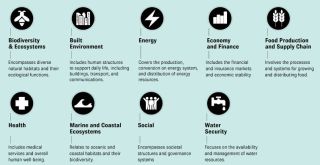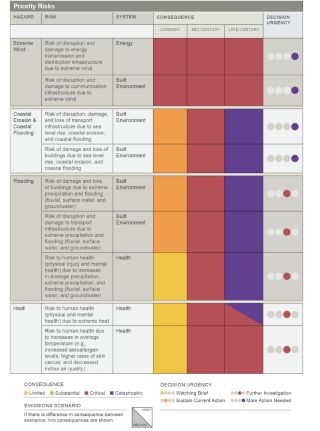National Climate Risk Assessment

The EPA has published the National Climate Change Risk Assessment which provides the first comprehensive assessment of where, when and how climate risks are likely to impact Ireland over the coming decades. The Risk Assessment identifies 115 risks from projected changes in climate conditions. Of these, 43 are deemed significant risks. The risks span all sectors of our economy, society, and environment from energy, transport and communications to water security, public health, food production and supply and ecosystems.
Main findings
The National Climate Change Risk Assessment provides government, business, communities and other stakeholders with the best available evidence and analysis to inform climate adaptation and resilience in Ireland at a national level. The risk assessment will support the development of Sectoral Adaptation Plans by key government departments, will guide the development of local authority adaptation plans and inform other national level adaptation responses. The Risk Assessment identifies 115 risks from projected changes in climate conditions. Of these, 43 are deemed significant risks. The risks span all sectors of our economy, society, and environment from energy, transport and communications to water security, public health, food production and supply and ecosystems.

Significant Climate Risks for Ireland
The NCCRA identifies priority risks that require additional action in the next five years to increase resilience.
- Extreme Wind:
The risks of disruption and damage to both energy transmission and distribution infrastructure and communication infrastructure due to extreme wind are considered priority risks for Ireland, as these infrastructures provide critical services and functions that other systems require to operate. Ireland’s exposure to these risks was recently demonstrated through the unprecedented number of power and communications outages from Storm Éowyn in February 2025. While climate projections show limited changes in the frequency and intensity of extreme wind events in the future, there is a high degree of uncertainty associated with these projections. Current measures are deemed insufficient to offset current and potential future adverse impacts, with more action needed in the next five years to increase the resilience of the energy transmission and distribution infrastructure and communication infrastructure.
- Coastal Erosion and Coastal Flooding:
Ireland’s coastline is already experiencing the impacts of coastal erosion and flooding; these impacts are projected to increase in the future under all future climate scenarios. Buildings and transport infrastructure concentrated in coastal areas in and around Dublin, the southeast, and the southwest are considered particularly exposed to the impacts of coastal erosion and coastal flooding. On a national basis, more action is needed in the next five years to enhance the resilience of coastal areas and transport infrastructure to cope with projected increases in the frequency and intensity of coastal erosion and coastal flooding. This includes ensuring that the best available estimates of potential coastal change and associated hazards and risks are identified, refined, and updated on an ongoing basis.
- Flooding:
Changes in precipitation patterns will result in an increase in the frequency and severity of river, surface water, and groundwater flooding events. Due to the prevalence of hard surfaces which exacerbate flood risk, the Built Environment is considered particularly exposed to flood-related impacts, with transport infrastructure and buildings highly exposed, with the consequence of these risks increasing to critical by mid-century, with potential to reach catastrophic levels of consequence by the end of the century. Flooding also poses a risk to the health of human populations, including both physical (e.g. injuries and deaths) and mental health impacts (e.g. chronic anxiety, depression and post-traumatic stress disorder). Current measures are deemed insufficient to fully offset adverse impacts of flooding with further investigation required, such as development of projections of groundwater flooding and national hazard maps of surface water flooding, to determine areas of exposure and the actions that are required to enhance the resilience of the buildings, transport infrastructure, and communities to flood risk.
- Heat:
By the end of the century extreme heat is identified as a priority risk. This is due to projected increases in the frequency and severity of extreme heat events, combined with a projected increases in population and an increase in the those considered vulnerable to heat-related impacts, i.e., those over 65-years old. Current understanding of these risks is limited with further investigation required, this includes increasing the understanding of the relationships between changing climate conditions and potential impacts to support robust risk assessments. For example, at the national scale, there is a requirement for more detailed assessment of the impacts of changing climate conditions on levels of exposure to UV radiation, aero-allergens and air quality. Further investigation is also needed to determine how different communities and populations are or become more vulnerable to extreme heat and increased temperatures, due to factors such as socio-economics or pre-existing health conditions.
Figure 1: Most significant risks related to climate change

Cascading Risks
The report identifies 115 risks for the nine systems. However, identified risks within one system have the potential to cascade and impact upon other systems. For example, extreme winds during Storm Darragh in December 2024 and Storm Éowyn in February 2025 resulted in damage and disruption to the energy system resulting in approximately 395,000 households, farms and businesses losing power. This also led to cascading impacts on other sectors, including communication networks and water treatment and supply. It is important to understand the relationship between systems and the associated cascading impacts so that a risk can be appropriately managed. In assessing the consequence of identified risks, the NCCRA identifies the cascading impacts across systems, with the Biodiversity & Ecosystem, Economy & Finance, Health, and Social systems, particularly impacted by risks from other systems.
Recommendations
Key recommendations to inform and strengthen future iterations of the National Climate Change Risk Assessment include:
- Continue the development of climate and hazard data to address data gaps, and to develop data that is consistent across geographic areas, timeframes, and climate projections.
- Further integrate non-climatic drivers of risk such as urbanisation, pollution, socioeconomic processes, population growth, and land use change, to account for their influence on the overall level of risk from climate change hazards.
- Include financial quantification of the estimated direct and indirect costs of climate risks, such as the costs of response and repair, interruption to business activity, and implementing adaption actions.
- Address transition risks, i.e., risks emerging because of the transition to a low carbon and more sustainable economy.
- Address compounding and interacting hazards (where multiple hazards occur at the same time or sequentially, increasing the overall severity of risk).
- Expand the assessment of transboundary risks which cross national boundaries and assess multiple countries by assessing the level of consequence, uncertainty, decision urgency, and cascading impacts of transboundary risks.
Social Justice Ireland view:
Ireland faces some critical decisions on climate mitigation and investment in the next five years. The significant investments and policy change required to meet out national and international climate commitments will need to be frontloaded in the next two years to support emissions reductions later in the decade if we are to have any chance to meet our 2030 targets. In order to make sure we make the right investments in the right policies now, Government must ensure that it incorporates all available data and research into decision making. The NCCRA findings should inform decisions regarding investment in climate adaptation and mitigation as a priority. Strong policies with clear adaptation goals, defined responsibilities and commitments that are coordinated across Government and across sectors can deliver progress on mitigating the worst impacts of climate change. This requires mainstreaming climate adaptation into our annual budgetary cycle, regular monitoring and evaluation and an inclusive governance that prioritises policies that address specific inequities based on gender, ethnicity, disability, age, location and income.